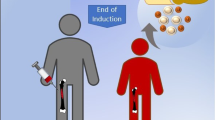Abstract
Blinatumomab enhances survival in patients with B-cell precursor acute lymphoblastic leukemia (B-ALL) by inducing T cell activation. However, approximately 50% of patients with relapsed or refractory B-ALL do not respond to blinatumomab, and the correlation between T cell phenotype and blinatumomab response remains unclear. To assess this correlation, we longitudinally compared immune checkpoint molecules in T cells before and during blinatumomab treatment between a responder and non-responder. In the responder, the expression level of granzyme B increased following infusion of blinatumomab and complete remission was achieved. On the other hand, the non-responder consistently expressed higher levels of programmed death-1 (PD-1), T cell immunoglobulin and mucin domain 3 (Tim-3), and T cell immunoreceptor with immunoglobulin and ITIM domains (TIGIT) in CD8 + T cells than the responder during blinatumomab treatment and showed no response despite the addition of two donor lymphocyte infusions. Furthermore, the residual tumors in bone marrow after blinatumomab treatment showed increased expression of immune checkpoint ligands: PD-L1 (PD-1 ligand), Galectin-9 (Tim-3 ligand), PD-L2 (PD-1 ligand) and CD155 (TIGIT ligand). In conclusion, immune checkpoint molecule levels could correlate with response to blinatumomab.


Similar content being viewed by others
References
Haas C, Krinner E, Brischwein K, Hoffmann P, Lutterbüse R, Schlereth B, et al. Mode of cytotoxic action of T cell-engaging BiTE antibody MT110. Immunobiology. 2009;214:441–53.
Kantarjian H, Stein A, Gokbuget N, Fielding AK, Schuh AC, Ribera JM, et al. Blinatumomab versus chemotherapy for advanced acute lymphoblastic leukemia. N Engl J Med. 2017;376:836–47.
Zhu M, Kratzer A, Johnson J, Holland C, Brandl C, Singh I, et al. Blinatumomab pharmacodynamics and exposure-response relationships in relapsed/refractory acute lymphoblastic leukemia. J Clin Pharmacol. 2018;58:168–79.
Duell J, Dittrich M, Bedke T, Mueller T, Eisele F, Rosenwald A, et al. Frequency of regulatory T cells determines the outcome of the T-cell-engaging antibody blinatumomab in patients with B-precursor ALL. Leukemia. 2017;31:2181–90.
Aldoss I, Song J, Stiller T, Nguyen T, Palmer J, O’Donnell M, et al. Correlates of resistance and relapse during blinatumomab therapy for relapsed/refractory acute lymphoblastic leukemia. Am J Hematol. 2017;92:858–65.
Kohnke T, Krupka C, Tischer J, Knosel T, Subklewe M. Increase of PD-L1 expressing B-precursor ALL cells in a patient resistant to the CD19/CD3-bispecific T cell engager antibody blinatumomab. J Hematol Oncol. 2015;8:111.
Feucht J, Kayser S, Gorodezki D, Hamieh M, Döring M, Blaeschke F, et al. T-cell responses against CD19+ pediatric acute lymphoblastic leukemia mediated by bispecific T-cell engager (BiTE) are regulated contrarily by PD-L1 and CD80/CD86 on leukemic blasts. Oncotarget. 2016;7:76902–19.
Webster J, Luskin MR, Prince GT, DeZern AE, DeAngelo DJ, Levis MJ, et al. Blinatumomab in combination with immune checkpoint inhibitors of PD-1 and CTLA-4 in adult patients with relapsed/refractory (R/R) CD19 positive B-Cell acute lymphoblastic leukemia (ALL): preliminary results of a Phase I study. Blood. 2018;132(Suppl 1):557.
Nagele V, Kratzer A, Zugmaier G, Holland C, Hijazi Y, Topp MS, et al. Changes in clinical laboratory parameters and pharmacodynamic markers in response to blinatumomab treatment of patients with relapsed/refractory ALL. Exp Hematol Oncol. 2017;6:14.
Wong R, Pepper C, Brennan P, Nagorsen D, Man S, Fegan C. Blinatumomab induces autologous T-cell killing of chronic lymphocytic leukemia cells. Haematologica. 2013;98:1930–8.
Zhang X, Zhang H, Chen L, Feng Z, Gao L, Li Q. TIGIT expression is upregulated in T cells and causes T cell dysfunction independent of PD-1 and Tim-3 in adult B lineage acute lymphoblastic leukemia. Cell Immunol. 2019;344:103958.
Author information
Authors and Affiliations
Corresponding author
Ethics declarations
Conflict of interest
The authors have no conflict of interests relative to this manuscript.
Additional information
Publisher's Note
Springer Nature remains neutral with regard to jurisdictional claims in published maps and institutional affiliations.
Supplementary Information
Below is the link to the electronic supplementary material.
About this article
Cite this article
Kobayashi, T., Ubukawa, K., Fujishima, M. et al. Correlation between increased immune checkpoint molecule expression and refractoriness to blinatumomab evaluated by longitudinal T cell analysis. Int J Hematol 113, 600–605 (2021). https://doi.org/10.1007/s12185-020-03047-w
Received:
Revised:
Accepted:
Published:
Issue Date:
DOI: https://doi.org/10.1007/s12185-020-03047-w




